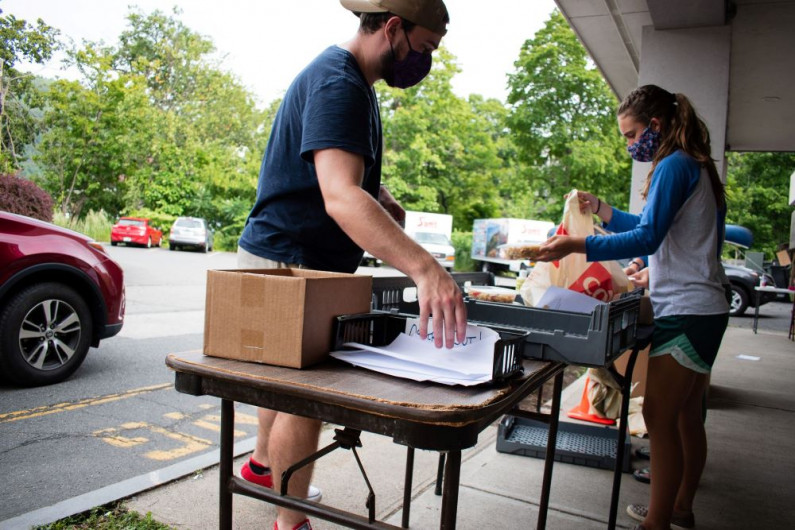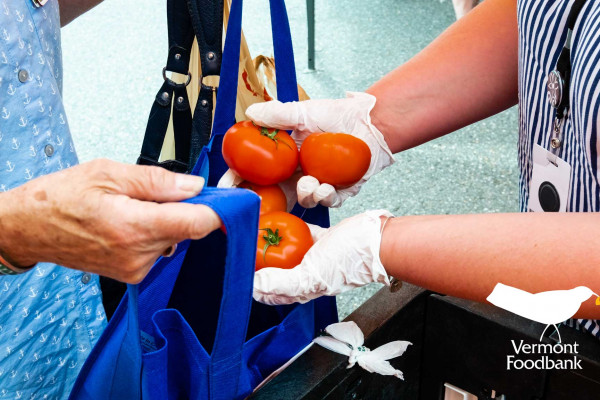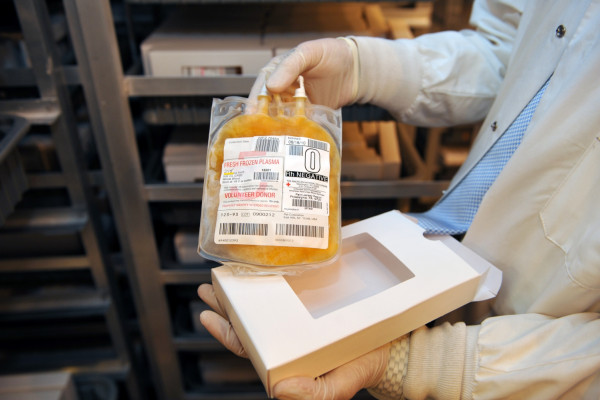The Vermont Foodbank, a Feeding America member, works with over 215 network and agency partners throughout the state to provide nutritious food to over 153,000 Vermonters each year.
Read more about "Vermont Foodbank Ensures Food Access for Most Vulnerable"Share Our Post:
The VT COVID-19 Response Fund Recovery Initiatives: A Q+A on Food System Resilience

Photo credit: Frances Huntley, staff of Downtown Brattleboro Association and Site Director of Everyone Eats.
The Community Foundation established its VT COVID-19 Response Fund in March 2020 to encourage collective, coordinated grantmaking efforts that can quickly adapt to changing circumstances. Since that time, grants have gone to ensure vulnerable populations receive basic needs—something that is top of mind given recent spikes in cases. In September 2020, we announced five recovery initiatives that address key challenges magnified by the pandemic: Rural Entrepreneurship, Food System Resilience, Rural Connectivity, Learning in Transition, and Welcoming, Equitable, Anti-Racist Communities. Through focused grantmaking, our goal is to set the state on a pathway to more equity and greater resilience in the face of future disruption.
Food System Resilience
Farming and farm-based products are embedded in the cultural fabric of Vermont. Agriculture may not look like it did fifty years ago but it is still critical to Vermont’s economy, health, and working landscape. This has proven to be fundamental to our resilience during the pandemic. Vermont’s food system—growers, processors, distributors, restaurants, grocery stores, farmers’ markets, etc.—continue to meet the demand from local consumers uncertain of national supply chains and they are stretching in new ways to ensure no Vermonters go hungry.
The incredible feat of keeping Vermonters fed—and farm and food businesses thriving—during a pandemic has required creative thinking, tireless work, and of course, capital. With all that collaboration and investment over the last nine months, the question becomes how to sustain and extend these connections going forward? Finding the answer is the underlying goal of the Vermont Community Foundation’s Food System Resilience recovery initiative. The Community Foundation’s Sarah Waring, vice president for grants and community investments, and Chelsea Bardot Lewis, senior philanthropic advisor, have worked closely with Gaye Symington, president of the High Meadows Fund, to design this initiative. This conversation represents perspectives from all three.
Why has the Community Foundation decided to focus on Food System Resilience as part of its pandemic recovery strategy?
Since March, the Community Foundation has made grants to ensure Vermonters’ basic needs are met, and food is high on that list. With one in three Vermonters experiencing food insecurity since the start of the pandemic, the charitable food system continues to be stretched.
In Vermont, local farmers, local food producers, and local restaurants have changed the way they do business to make sure neighbors are fed. Setting up online platforms, coordinating delivery services—it was inspiring to watch how innovative food businesses pivoted to help consumers feed their families safely, and strategize how they could help support the local charitable food networks. We want to reinforce this infrastructure and make it a model for our post-pandemic communities.
During the same time, on the national stage, there has been severe supply chain disruption due to COVID-19. Some farmers and producers benefitted from increased consumer awareness and local purchases, while others faced financial losses as some of their most reliable markets (e.g., cafeterias and restaurants) closed. The pandemic impacted the way people shop for food, and we see an opportunity to take advantage of the moment and support Vermont farmers and producers to reinforce their business’ viability by expanding their customer base.
This initiative is about two things—making sure Vermont can feed Vermonters in times of crisis and making sure Vermont’s producers and farmers can weather the disruption and follow a road to future business growth.
What does a grantmaking strategy in support of Food System Resilience look like in action?
For this strategy, we took a lead from the High Meadows Fund, which has long advocated that farm enterprises that care for the land and grow healthy food are critical to Vermont’s economy, as well as to the resiliency of our state. Their history of grantmaking around this commitment helped to articulate our own strategy, which can be broken down into three major buckets.
We want to maintain the infrastructure of the community-based food assistance initiatives inspired by the pandemic. Along with High Meadows, the Community Foundation helped launch the Shift Meals program as part of its response grantmaking, which has evolved into the statewide Vermont Everyone Eats program after an infusion of funding from the federal government and other philanthropists. The program has been a lifeline for restaurants, farmers, and the thousands of people who would otherwise not have access to healthy, locally produced meals. With federal funding running out, we are providing transitional support to community hubs so they can hold up the infrastructure already in place and it doesn’t have to be rebuilt in the future.
We want to improve farm viability by supporting Vermont’s food hubs to expand market access outside of the state. A quick refresher: food hubs facilitate the aggregation, storage, processing, distribution, and/or marketing of locally produced food products. The pandemic increased the demand for Vermont-produced food. This came at a time when food hubs across the state were already working to formalize collaboration to reach new markets in bigger ways. We are supporting Vermont’s Food Hub Collaborative as they launch a new brand and make a big marketing push to reach customers in the greater Boston region.
We want to support dairy farmers as they explore ways to remain in farming. The dairy sector is in a point of transition, with many farmers realizing it is no longer lucrative to rely on commodity fluid milk. We are exploring grants around dairy diversification—looking at beef, goat dairy, value-added products like cheese, etc. We want to understand what the opportunities are to take advantage of intellectual capital and land base but offer more stability in today’s markets.
What does success around Food System Resilience look like? How will it help make Vermont better for all Vermonters?
Success for this initiative is two-fold. The most fundamental principle of a resilient food system is that you and your neighbors are fed. We believe that every Vermonter wants to see food insecurity addressed. We want to reinforce and ensure strong connections between the people who grow food, prepare food, and need food.
Success is also linked to the continued viability of agricultural businesses in Vermont. We want each generation of Vermonters to see farming as a profitable business opportunity consistent with clean water and healthy soil. We want to strengthen the connectivity between consumers and where food comes from, maintain the cultural significance of agriculture in the state, and protect Vermont’s natural resources. In these business models, as we think about the future, we are eager to see the value of the dollars spent returned to the farmers and producers who are the beginning of the food chain.
What hurdles currently stand in the way of success around this initiative, and how will they be addressed?
We see a few distinct hurdles.
There is no one prescription for a new business model for all the dairy farms in Vermont that might be suffering. Farming is a hard and risky business, and any transition of our largest agricultural sector will take years, rather than months. We do not anticipate the current economic downturn to be short-lived, which means that the conditions of economic decline for dairy are likely to continue.
Even after a vaccine is widely available, there will still be a significant number of people at risk of or experiencing food insecurity. Vermont’s key food insecurity and hunger relief leaders, such as Hunger Free Vermont and the Vermont Foodbank, are likely to advocate for changes to publicly supported food programs that look for that double impact—local food into the emergency supply chain, and accessible, equitable ways to move food to those in need. We can play some role, but the public sector needs to play a major role in ensuring all Vermonters are fed and local food is included in food distribution programs.
Sustaining interest in the Vermont brand among consumers here and out-of-state once the pandemic is over will also be a potential challenge. There is a lot of private investment in understanding what food consumers are demanding and making it very easy to access it—whether that is locally produced or grown across the country. How do we continue to make Vermont stand out as a differentiating value for consumers?
How can the Community Foundation’s fundholders and donors help support its work around Food System Resilience?
Many communities are making sure that local people in need are getting local food as a part of their emergency support. Donors can check out the statewide programs Vermont Everyone Eats and the Vermonters Feeding Vermonters or other local food pantries and food shelves. It is also critical to support your local growers, producers, sellers, and especially restaurants. This is an incredibly rough period for the local restaurant industry that is so dependent on tourism.
Find your entry point into the food system by purchasing food that is made in Vermont. Buying local keeps people employed and fed at the same time—that’s the impact we’re hoping to make!
Don't forget to check out our other VT COVID-19 Response Fund Q+A's:


